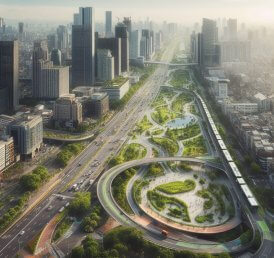Public Space and our Cities

By Zumer Zia
Inhabitants of Pakistani cities are faced with a lack of access to public spaces. While this concerns every segment of the population, women, children, the elderly, and the disabled are affected significantly more. The onset of the COVID-19 pandemic highlighted the appalling situation when everyone was subjected to lockdown, with little avenues left for entertainment. As restaurants and shopping malls closed, people headed towards parks and open spaces for recreational activities. Here, almost all of us realized that there is a dearth of parks and green areas in our cities. The existing ones are not well maintained, and residents of many communities were forced to undertake their daily walks on the edges of roads, due to the absence of sidewalks.
When thinking about public spaces, our consciousness directs us towards parks and green spaces. While these are of extreme importance from a public health point of view, it must be recognized that the definition of public space also includes public transport and community centers. Community centers allow communities to interact and socialize, which is significant especially in this age of disconnections where even neighbors are not familiar with each other. They provide opportunity for volunteering, instilling a sense of public service in the new generation, and serving as a useful utilization of time. In community centers, the public can join to carry out small projects for the betterment of their cities. For example, cleanups and gardening drives can be organized, allowing citizens to take ownership of their cities, and declare their rights over them, as discussed by Lefebvre and David Harvey.
They are an effective means to combat loneliness, especially for homemakers and the elderly, as they do not venture out into public much. Despite being agglomerations of people and communities, urban loneliness is a phenomenon that is increasing worldwide, as social connections become severed and strained. In this situation, community centers can play a vital role in bringing people together. Youth comprises a significant portion of the population of Pakistan and are at the brink of a crisis due to lack of good educational facilities, unemployment, and rising extremism. Community centers can counter this by providing avenues for creativity and skill development by providing short courses and activities directed towards youth. In the cities of Pakistan, even health comes at a price, due to the scarcity of parks and expensive gyms. Community centers can promote healthy lifestyles by arranging free-of-cost physical activities for citizens. Public transport is also an essential component of public space, as it connects all strata of society during their daily commute and is a means of countering extremism and encouraging tolerance.
The reasons for this severe lack of public space are two-fold. Firstly, Pakistani cities are designed for cars, and not for people. The physical space is laid out for the smooth functioning of traffic, and roads are widened to allow room for more cars. The pedestrian is relegated to the edges of roads, where no sidewalks exist. Most of the space is allocated for roads and parking spaces, which leads to a paucity of space for walkable zones and public parks. Secondly, an interdisciplinary approach is not implemented while planning and managing cities. The urban realm is not only the domain of engineers and urban planners, but of everyone who lives in the city. While an engineer may be able to determine how to construct a building, a sociologist can contribute towards making that building a healthy public space.
Due to non-existent public spaces, we have become a disunited and fragmented society. While some of us live in gated communities, others dwell in slums with all sections being alienated from each other. We are many worlds in one and extremely compartmentalized, with the public realm severely lacking. Therefore, it is extremely essential that the government focuses on the establishment and development of public spaces including parks and community centers.



